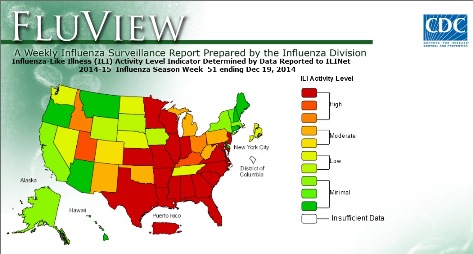The flu has now reached an epidemic level, according to Dr. Lee Norman of the University of Kansas Hospital in Kansas City, Kan.
Dr. Norman said that the Kansas Department of Health and Environment is now using the term “epidemic” to describe it. He said KU Hospital here currently has 36 inpatient possible flu cases. Twenty-five were confirmed with influenza and 11 more are in the process of being tested for it, he added.
The hospital has seen two deaths from the flu, including one two weeks ago and another last week, he said.
He said in his eight years as chief medical officer at KU Hospital, he had never seen this level of the flu. He could recall only 10 cases or so of flu admissions at any given time.
KU Hospital employees have not been particularly hard hit by the flu, according to Dr. Norman, as they were all required to get flu shots.
Larry Franken, epidemiologist with the Wyandotte County Health Department, said Wyandotte County has had about 200 flu cases that were recorded this season, which is high. Nationwide, there have been an estimated 1,000 deaths.
Dr. Norman said there has been a lot of outpatient activity from the flu, with urgent care centers glutted with patients.
Some hospitals are now on diversion because of the spike in the number of flu cases, he said. When a hospital is on diversion, a patient may have to be taken to a different hospital.
With the overcrowding of medical facilities, he said local health officials are beginning to talk about setting up alternative care sites, just for acute respiratory care.
It’s not too late to get a flu shot, and although it doesn’t completely cover all of this year’s flu strains, it will lessen the severity of the flu, according to health officials.
Franken said he has seen a big spike in flu cases in the last few weeks.
Besides getting the flu shot, it is important for persons and children to stay home if they are sick, he said, and to cover coughs. Keep your distance from people who might be sick, and reduce spreading the flu to others, he said.
Dr. Norman said complications from the flu can result in more serious illness and death. Bacterial pneumonia sometimes results from the flu, and in other cases, staph or MRSA (methicillin-resistant staphylococcus aureus) could develop.
Franken said typically, January and February is when the flu is at its highest peak. This year it has been an early flu season, he added.
There are other respiratory illnesses going around besides the flu. Typically, the flu will include a fever with chills, muscle aches and headaches, according to Dr. Norman.
Elementary, secondary schools and colleges here are currently on break, which means students are not coming into contact with each other as much as they did before the holidays. Several businesses also are on a winter break, including the two auto plants in Greater Kansas City, and it is also a time when some people take extra vacation days.
However, New Year’s Eve is coming up Dec. 31, when there are many social events planned throughout the area.
Health officials encouraged anyone who is sick to stay home and not to spread the flu.
Centers for Disease Control flu maps show that the flu is widespread in many areas in the United States currently.

